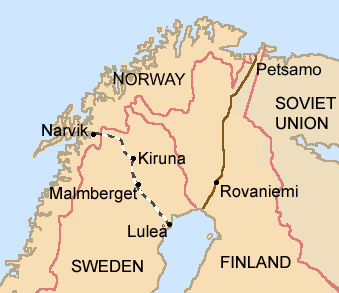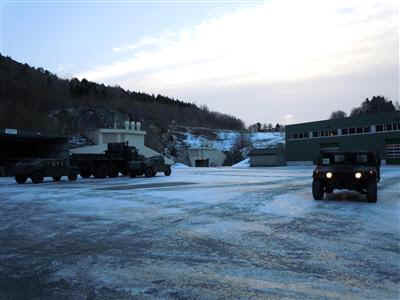After the end of the Vietnam war, the U.S. military focused on the Soviet threat. The Reagan administration entered office with plans for huge increases in military spending, justified with huge exaggerations of the military capabilities of the Soviet Union. The U.S. Marine Corps needed a role in NATO if it wanted a piece of this larger pie. Simply dispatching its 2nd Division to reinforce the U.S. Army was a bland idea from World War I. A unique mission was desired, resulting in a sales pitch that U.S. Marines were needed for the defense of Norway. The Soviet Union's northern port at Murmansk froze over during the winter, and a year around warm water port would be helpful. The Soviets might push down the Norwegian coast and seize the warm water port of Narvik. Norway has only 4.5 million citizens and a small army, so U.S. Marines could help repel the Soviets.
 This
looks plausible when presented on a map, yet critics pointed out
that northern Norway is above the Arctic circle and very, very cold and mountainous,
with a narrow,
single mountain road to the Soviet Union. The Norwegians had planted
explosives and built small forts so they could easily block this path within
minutes of war. This objection was overcome by suggesting the Soviets could
mount an amphibious end run down the coast to seize Narvik. Critics noted that
operation would prove extremely risky, and the Soviets didn't have many amphibious ships. Moreover, it would still takes months to repair and clear the road to
Petsamo, and the route would still be very difficult for trucks.
This
looks plausible when presented on a map, yet critics pointed out
that northern Norway is above the Arctic circle and very, very cold and mountainous,
with a narrow,
single mountain road to the Soviet Union. The Norwegians had planted
explosives and built small forts so they could easily block this path within
minutes of war. This objection was overcome by suggesting the Soviets could
mount an amphibious end run down the coast to seize Narvik. Critics noted that
operation would prove extremely risky, and the Soviets didn't have many amphibious ships. Moreover, it would still takes months to repair and clear the road to
Petsamo, and the route would still be very difficult for trucks.
As a result, another possibility was ginned up. The Soviets could cut across the open plains of northern Finland and Sweden and seize Narvik along with coal mines in the region. That would provoke war with Finland and Sweden, but it was a plausible sales pitch. In reality, if the Soviets had invaded West Germany, they would have devoted all resources at that main effort, and not waste combat power on a difficult fight near the Arctic circle while adding Finland and Sweden to its list of enemies.
Nevertheless, the Marines were allowed to play the Norway game, and conducted annual reinforcement exercises. Equipment for a 15,000-man Marine Air-Ground Task force was "prepositioned" in central Norway. If war erupted, Marines could fly in and pull equipment and supplies out of storage from several locations:
Ground Equipment Caves
Frigaard 139,936 sq.ft.; Tromsdal 171,349 sq.ft.; Bjugn 110,000 sq.ft.
Aviation Support Equipment
Vaernes Air Station (Rotary) 60,500 sq.ft.; Oerland Air Station (Fixed) 60,500 sq.ft.
Ammunition Caves
Hammernesodden; Hammerkammen; Kalvaa
After the Cold War ended, Marines assumed this Norway mission would quickly go away. The only value of Norway trips was cold weather training, but that was available at the Corps' huge cold weather training facility in Bridgeport CA, or the Army's school in New Hampshire. However, many businesses were profiting off the Norway "Pre-po" game, and used their influence to keep it in place. This dubious Cold War program evolved into a racket, something described in 1933 by retired Marine Major General Smedly Butler:
"A racket is best described, I believe, as something that is not what it seems to the majority of people. Only a small inside group knows what it is about. It is conducted for the benefit of the very few at the expense of the masses."
To help hide this racket, the storage program was renamed MCPP-N and touted as part of a worldwide stockpile, which was promoted as cost effective since Norway paid to maintain the storage facilities. However, this equipment is not easily accessible near the Arctic circle, and not adjacent to ports for rapid embarkation. The cost of rotating this equipment every three years to the USA for testing and overhaul is huge. It was obvious to everyone that this equipment should be placed at navy ports and airfields near areas of potential conflict, like: Guam, Italy, Bahrain, or Key West.
 The last Pentagon
review of our overseas base structure was in 2005 as Secretary of Defense
Donald Rumsfeld attempted to pry our military out of a Cold war posture.
That 2005 commission recommended
modest realignments, and summarized the ill defined value of the Marine program
in Norway:
The last Pentagon
review of our overseas base structure was in 2005 as Secretary of Defense
Donald Rumsfeld attempted to pry our military out of a Cold war posture.
That 2005 commission recommended
modest realignments, and summarized the ill defined value of the Marine program
in Norway:
"The Marine Corps, with agreement from the capabilities-Norway government of Norway, has assigned a new global mission for the Norway Air-Landed operational area, it is not clear how these capabilities would be employed or what operational value they add to current capabilities."
As the fighting in Iraq and Afghanistan continued, the Marine Corps began to suffer serious equipment shortages. A quiet rebellion broke out among those who manage Marine Corps equipment. They wanted to divert equipment destine for Norway to fully equipped Marine units deploying to combat. They were angered and disgusted when permission was denied, with the laughable excuse that keeping equipment in Norway was a vital to the Marine Corps' commitment to the defense of Norway. All this was after the Warsaw Pact and the Soviet Union dissolved, and after the weak Russian military struggled to squash a rebellion in Chechnya. As a final blow to the absurd idea that Russia may invade Norway, global warming melted so much Arctic ice that Murmansk became a year around ice free port!
The issue was dropped after Marine Generals secured hundreds of millions of dollars in additional funding to fully restock equipment. In 2011, the annual Norway Pre-Po sales campaign included a ludicrous "exercise" in which equipment was pulled from caves in central Norway and shipped all the way to Romania and back to prove the value of keeping Marine Corps equipment in Europe.
As the era of blank check military funding ends, the Marine Corps still faces equipment shortfalls. The Marine Corps should be directed to end its MCPP-N program, pull its equipment out of Norway, and distribute it to units that need it, or store some at Navy bases near potential trouble spots, because the Russians will not invade Norway!
Carlton Meyer editorG2mil@Gmail.com
©2011 www.G2mil.com